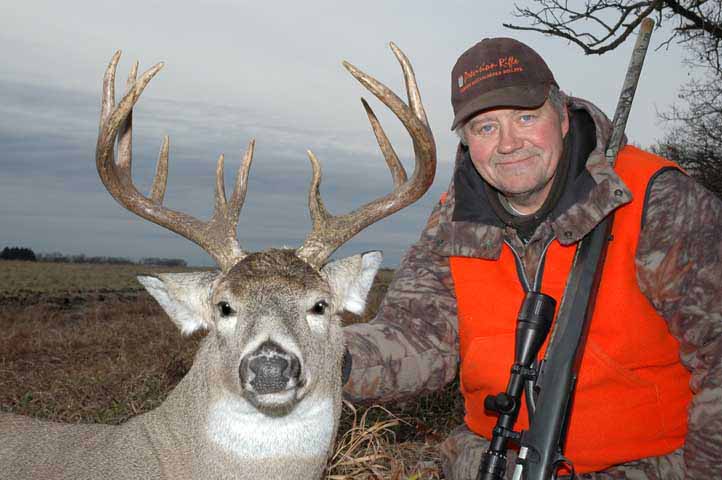Ruger
77 Custom Muzzleloader
Posted 6 / 05 / 03

I
decided to include this web page on my custom 77 Ruger muzzleloader after
receiving e-mail daily requesting a full description of the gun. I would like
to say that I did not build this muzzleloader for commercial purposes but
rather out of frustration and to attempt to prove several theories that I
had running loose inside my head.
THE IRON:
This rifle started life as a Ruger 77 in .250/3000. I removed the barrel and
replaced it with a .45 caliber 1:30" twist 25" fluted Green Mountain
barrel. I had an excellent machinist make me a breach plug out of 4140 and
the above pictured primer holders out of solid brass. I then added a 20"
1:28" twist Green Mountain .50 caliber barrel for stand and rattling
style hunting and a 25" 1:28" twist Green Mountain .50 caliber barrel
for long range heavy bullet work. The stock is an after market synthetic.
All three barrels and the stock were then film dipped in Skyline Excel. All
three barrels have an index mark that matches an index on the receiver and
can be removed / installed with a strap wrench.
THE PRIMER HOLDER:
The primer holders are machined out of solid brass and are the same dimensions
as a standard head sized brass case ( .22-250, .243, 6mm, .308 etc.). They
accept a small rifle primer rather than a 209 or large rifle primer. They
have the same size flash hole as a .222 Remington case.
WHAT IS THE POINT:
I was unhappy with 209 ignition. I believe that the 209 has so much energy
that in some cases it will actually push the sabot off the powder charge while
igniting the powder. I believe that this is the cause of many of those "unexplained
flyers". My small rifle primer equipped Ruger has yet to throw an unexplained
flyer and the Standard Deviation with this breach plug / small rifle combination
are the lowest I have ever recorded with any muzzleloader.
I was unhappy with the fouling that standard breach plugs with 209 primers
throw all over the action, into the trigger and on my favorite scope. With
the exception of the Knight Disc Extreme, all other breach plugs allow fouling
into most parts of the action. While the Knight seals the breach, I wanted
something more substantial between the 209 and my eyes than a piece of plastic.
I have used my primer holders over 100 times and the primer fits at tight
now as it did when new. I decap them with a small punch and mallet and prime
them with a Lee Priming tool. Additional fine tuning can be accomplished by
using Bench Rest, Standard or Magnum primers to suit the charge of powder.
I was unhappy with the constant change of impact of muzzleloaders due to most
only having one screw holding them into the stock. The rocking motion that
occurs every shot causes large groups and point of impact shifts. The 77 Ruger
action has three guard screws and once bedded, the point of impact never changes
and accuracy is deadly consistent.
I was unhappy with the trigger pulls of most muzzleloaders. Heavy, lots of
travel and no adjustment. Worse than having a bad trigger is that you cannot
buy a better trigger in most cases because there is not one available. The
77 Ruger trigger easily adjusts below three pounds with very little travel
and no creep. A variety of fine after market triggers are also available to
get down under two pounds if required.
IN CLOSING:
 I
can tell you that today I am very happy with my Ruger. It shoots great, never
changes point of impact, has a very consistent trigger and is very clean.
I can finally put my favorite scope on my muzzleloader without wincing every
time I pull the trigger. I refuse to attach a ramrod to it so the second shot
on a hunting trip might take a little longer. Probably not a big deal to assemble
my takedown ramrod as I have not taken a second shot while hunting in the
past five season. Although I have only had this rifle for about three months,
I am convinced that small rifle primers are the answer. They ignite any powder
as well as anything while creating less fouling near the breach plug and produce
no flyers. We will soon have more of them in the field as several of my customers
are shipping Ruger 77 actions for conversion. I will keep this page updated
as more data becomes available.
I
can tell you that today I am very happy with my Ruger. It shoots great, never
changes point of impact, has a very consistent trigger and is very clean.
I can finally put my favorite scope on my muzzleloader without wincing every
time I pull the trigger. I refuse to attach a ramrod to it so the second shot
on a hunting trip might take a little longer. Probably not a big deal to assemble
my takedown ramrod as I have not taken a second shot while hunting in the
past five season. Although I have only had this rifle for about three months,
I am convinced that small rifle primers are the answer. They ignite any powder
as well as anything while creating less fouling near the breach plug and produce
no flyers. We will soon have more of them in the field as several of my customers
are shipping Ruger 77 actions for conversion. I will keep this page updated
as more data becomes available.
2004 Version
Not
much stays the same except change itself. One of my shotguns shooting buddies
just had to have my 77 Ruger so down the road it went complete with the fluted
.45 caliber barrel.
To build the next one, I then found a 77 Mark II in .243 Winchester. The entire
gun was in terrific condition; wood stock and all. Thinking I may have some
use down the road for the .243, I took a different approach on preparing the
iron. Prior to removing the barrel, I ground a notch in the bottom of the
receiver and the barrel as reference marks. I then removed the .243 barrel
and headspaced the chamber so the barrel could be installed with a simple
strap wrench instead of a barrel vise. This entailed removing several thousands
off the face of the barrel. I installed and removed the barrel several times,
fired the gun each time; everything was good.
I had several tempered 416 stainless barrels from Green Mountain in the shop.
Tempered 416 is the same material that many smokeless cartridge barrels are
made from so strength was not an issue. I fitted a breech plug of 4140 into
the barrel that accepted Savage style interchangeable vent liners on the powder
end and shortened 6mm Remington brass on the bolt end. This would allow me
to use large rifle primers to ignite the various powders that I intended to
test. A dozen 6mm Remington brass were cut off and trimmed to be a zero fit
inside the breech chamber to create the perfect seal.
In order to preserve the .243, I would need to add an additional stock for
the much heavier muzzleloader barrel. Hogue makes a pillar bedded Varmint
style Rubber Overmolded stock for the Mark II that requires very minor barrel
channel opening for a perfect fit. True pillars of this stock assure great
accuracy and return to zero each time the gun is assembled. By adding a second
set of Ruger style rings, I could have both the muzzleloader barrel and the
.243 barrel roughly sighted in at all times.

162 yard shot - 240 Dead Center - 40.5 gr IMR 4759 - Federal
Large Rifle primer
This Ruger 77 Mark II version is a HUGE success. Both the muzzleloader and
the .243 shoot very well. I believe this to be the strongest and safest muzzleloader
I have ever come across. The Ruger is 100% clean, never changes point of impact
and shoots the same every day I take it out. Combined with our 240 Dead Center
and 40.5 grains of IMR 4759, I can shoot a 10" steel plate all day at
300 yards. Recoil is very mild with the Hogue stock. Accuracy runs around
.7" at 100 with the best day yielding a .778" 200 yard group.
Every 100 shots I remove the barrel, remove the breech plug, scrub the barrel
with a brass brush and Break Clean, replace the vent liner with a new .033"
flash hole vent liner and I am done. Assembly / reassemble takes only minutes
from muzzleloader to .243 and both return within 1.5" of point of impact.
Very cool. Very functional.
2005 Version
Over
the course of 2005 we built about 10 of these guns. Customers sent us their
77 Mark II actions and we sent them back a Custom Smokeless Muzzleloader.
Some in .45; some in .50. All shoot very well.